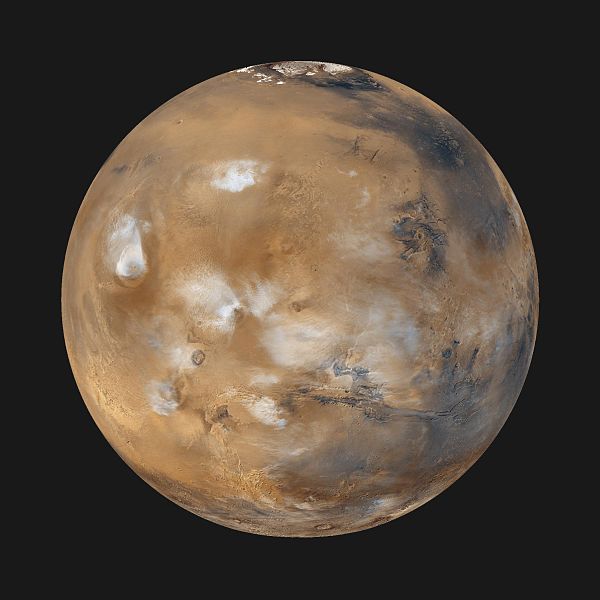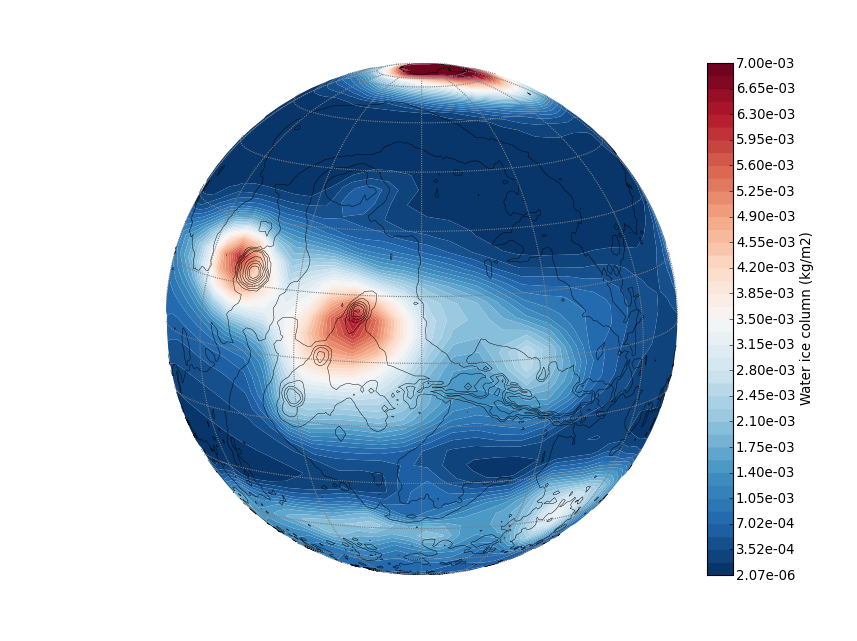Martian Climate Database Documentation
What Climate and Meteorology are there on Mars?
Just like on the Earth, there are winds and clouds on Mars...but also CO2 snow, dust storms and other exotic meteorological events!
Mars' atmosphere is a complete and complex system, governed by specific physical, dynamical and chemical processes, which can be observed and understood.
The
diurnal and seasonal cycles, combined to extreme and diversified topography, make the red planet's climate quite variable in space and time.
These variations can be modelled and predicted, and this is what the Mars Climate Database is about.

Mars Global Surveyor MOC wide angle camera mozaic
displaying water ice clouds,
from JPL.
What is the Mars Climate Database?
The Mars Climate Database (MCD) aims at providing scientists, engineers and enthusiasts with a realistic and reliable modelisation of the martian climatological system.
The MCD is a database of meteorological fields derived from General Circulation Model (GCM) numerical simulations of the Martian atmosphere and validated using available observational data.
The GCM is developed at Laboratoire de Météorologie Dynamique du CNRS (Paris, France) in collaboration with the Open University (UK), the Oxford University (UK) and the
Instituto de Astrofisica de Andalucia (Spain) with support from the European Space Agency (ESA) and the Centre National d'Etudes Spatiales (CNES).
The MCD is freely distributed and intended to be useful and used in the framework of engineering applications as well as in the context of scientific studies which require accurate knowledge
of the state of the Martian atmosphere.

Water ice column, extracted from the Mars Climate Database.
How to cite the Mars Climate Database ? (click to expand/fold section)
For general use of the MCD, please cite
Forget et al. 1999
and
Millour et al. 2018
.
For specific use of variables regarding:
What are the Dust and Solar Extreme UV scenarios? (click to expand/fold section)
Combinations of dust and solar scenarios have been used because these are
the two forcings that are highly variable from year to year.
-
On one hand, the solar conditions describe variations in the Extreme UV
input which control the heating of the atmosphere above 120 km, which
typically varies on a 11 years cycle. Depending on the scenarios,
either fixed (i.e. constant over time) solar maximum
average and/or minimum conditions are provided, or varying (i.e. changing from
day to day, as observed) realistic solar EUV.
-
On the other hand, the major factor which governs the variability in the Martian
atmosphere is the amount and distribution of suspended dust. Because of
this variability, and since even for a given year the details of the dust distribution
and optical properties can be uncertain, various model integrations
were carried out for the database assuming different "dust scenarios",
i.e. prescribing various amount of airborne dust in the simulated atmosphere. 5 dust
scenarios are proposed:
-
The Climatology (clim) scenario, which
is a simulation ran using the latest
version of the LMD Global Climate Model (GCM) forced by a dust
distribution reconstructed from observations over Mars Years 24 to 31, and thus
representative of a standard (i.e. devoid of a planet-encircling global dust
storm). This Climatology scenario is provided with 3 solar EUV
conditions: solar min, solar ave, solar max.
-
The cold scenario corresponds to an extremely clear atmosphere ("low
dust scenario"; where the dust opacity at a given location
is set to be the minimum observed over Mars years 24-31, further
decreased by 50%), topped with a solar EUV minimum thermospheric forcing.
-
The warm scenario corresponds to "dusty atmosphere" conditions, but nonetheless non-dust storm conditions (the dust opacity
at a given location is set to the maximum observed, unless during a
global dust storm, further increased by 50%), topped with a solar
maximum thermosphere.
-
The dust storm scenario represents Mars during a global dust storm
(dust opacity set to 5 at all times and over the whole planet). Moreover the dust optical properties are for this case set to
represent "darker dust" than nominal (in practice for these
runs, Ockert-Bell et al. dust properties were used, rather than
the more recently derived Wolff et al. ones).
This scenario is only provided for when such storms are likely to happen,
during northern fall and winter (Ls=180-360), but with 3 cases of solar EUV
inputs: solar min, solar ave, solar max.
-
The Mars Years scenarios (MY24, MY25, ..., MY32, MY33) correspond to our
best representation of these specific years, both in terms of daily
atmospheric dust loading and daily solar EUV input.
How does the MCD interpolate to high resolution topography? (click to expand/fold section)
The MCD access software includes a "high resolution" mode which combines high
resolution (32 pixels/degree) MOLA topography and the smoothed Viking Lander 1 pressure records (used as a reference to correct the atmospheric mass) with the MCD surface pressure in order to compute surface pressure as accurately as possible. The latter is then used to reconstruct vertical pressure levels and hence, within the restrictions of the procedure, yield high resolution values of atmospheric variables.
The procedure by which high accuracy surface pressure is computed is also implemented as a
light and autonomous tool (see user manual for more detailed explanations).
What's more in the full version of the MCD? (click to expand/fold section)
The full version of the MCD includes :
- the MCD access software, as a Fortran subroutine so that users can call it from their own programs;
- examples of interfaces to call the MCD from Python, C or C++ programs or IDL, Matlab and Scilab softwares;
- realistic added large scale and small scale perturbation schemes to represent the possible meteorology at a given location and time.
Complete documentation of the MCD (click to expand/fold section)
Interested readers are encouraged to read the following documents:
How does the LMD Global Climate Model (GCM) work? (click to expand/fold section)
A General Circulation Model (GCM) is a numerical model that computes the temporal evolution of the atmosphere of a planet. It solves well known equations of motion and thermodynamics on a 3D grid that covers the entire atmosphere.
The LMD Mars GCM accounts for the specific physical processes at work on Mars, from the surface to the exobase such as the condensation of the CO2 atmosphere during polar nights, the generation and evolution of water ice clouds, the distribution of airborne dust, the many chemical reactions that take place, etc.
 Mars Global Surveyor MOC wide angle camera mozaic
displaying water ice clouds, from JPL.
Mars Global Surveyor MOC wide angle camera mozaic
displaying water ice clouds, from JPL.
 Water ice column, extracted from the Mars Climate Database.
Water ice column, extracted from the Mars Climate Database.